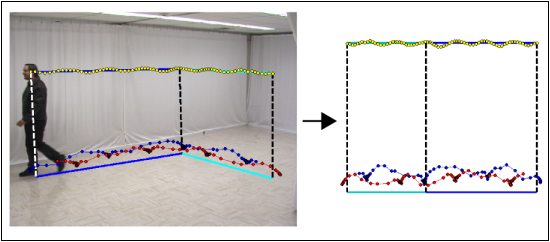| Modelling and Comparing Human Gait from Monocular Video Sequences |
| Ph.D. |
| Frédéric Jean |
| Robert Bergevin (Supervisor) |
 |
Problem:
The tracking and detection of people by means of a computerized system of cameras has been the subject of many research projects in the recent time. Several approaches have been proposed to solve this problem. However, these approaches are sometimes not realistic and often require a constrained environment as well as the cooperation of the people being observed. It would be interesting to be able to track and recognize people using more natural criteria and a less invasive approach, such as observing the gait of a person. A person’s gait is mainly characterized by the position of each of his limbs and the movement he carries out over time when he is walking. Consequently, the problem first consists in automatically finding and tracking principal body parts from a monocular video sequence. A gait model is then built from the body part trajectories. Finally, this gait model is compared to other existing gait models in order to verify if the currently observed person has been seen before.
|
Motivation:
This project is a continuation of the work carried out within the MONNET project (MONNET refers to Monitoring of Extended Premises: Tracking Pedestrians Using a Network of Loosely Coupled Cameras). The main objective of this project is to develop a computer vision system which can track people in various locations in real time for surveillance and security purposes. The system consists in a network of cameras connected to loosely coupled computing nodes which can communicate among themselves the information they have acquired in order to detect and track people.
|
Approach:
Most of the motions performed by a walking person involve the extremities, namely the head, the hands and the feet. Since hand motion is not constrained during the walk, only the head and the feet will be found and tracked. Thereafter, a normalization process will be developed in order to rectify the head and the feet trajectories. This normalization process is required in order to obtain body part trajectories that are invariant to the view and the changes in the walking direction. Finally, some gait characteristics will be extracted from normalized body part trajectories in order to build gait models of observed people. Several gait model types will be tested, and their discrimination potential will be analyzed and compared.
|
Challenges:
A system which models and compares people using their gait is not easy to design since it must function in real time, be robust and have a minimum of constraints. The system will be composed of several modules which must be executed one after the other in a minimal time frame for each of the images in a video sequence. The system will be confronted with a variety of situations such as the differences in the distance of people with respect to the cameras, the different points of view in which people will be observed, the noise from background subtraction, etc. All of these situations will make the task of tracking the body parts and modeling the gait of people more challenging.
|
Applications:
The proposed approach will provide a means of modelling and comparing people by their gait in some environments for specific applications. One of those applications consists in the surveillance of public areas in order to track people’s movements. The integration of the proposed approach into an intelligent human-computer system could be a possible application. Finally, this approach could be used in an authentification system for accessing restricted areas.
|
| |
Calendar:
May 2005 - May 2009
|
| |
| |
| Last modification: 2009/04/15 by fjean |

